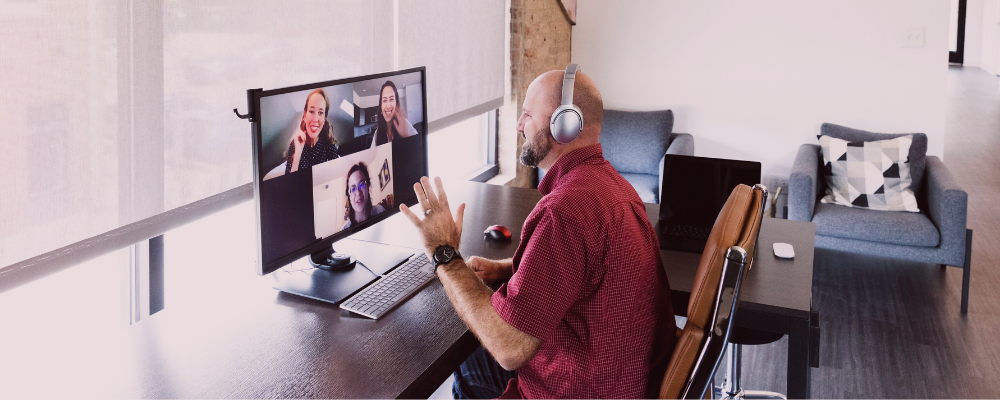Freedom, flexibility, unlimited casual Fridays—what’s not to like about being remote employees? Working from the comfort of your own home feels like the ultimate dream. But aside from the comfortability aspect, there’s a plethora of reasons why workers choose to ditch the office to operate remotely.
First and foremost, the finances. Those working from home just half of the time can experience savings as high as $2,500 and $4,000 annually 1 between transportation fees and car maintenance costs. Leaving the car in the garage during typical rush hour traffic saves a remote worker an average of 100 hours commuting and more than 40 long, irritable hours stuck in traffic each year.
There’s also a very hygienic draw to remote work. With the entire globe ravaged by the novel coronavirus in 2020, it’s no surprise general office workers would rather work from home than in their cubicle, or worse, an open-concept office. Remote work drastically reduces the chances of swapping germs with your coworkers and reduces the risk of unscheduled absences among your team.
75 percent 2 of remote employees claim they could continue to work safely from home, even if various teammates become ill. Plus, working from home removes the risk of missing work due to weather-related disasters or roadway problems. Considering unscheduled days off work typically cost U.S. companies a whopping $300 billion a year —$1,800 per employee—remote work seems like a win-win for everyone involved.

And did we mention productivity? An incredible 77 percent 3 of remote employees agree they’re more productive when working from home. Another 76 percent of remote workers prefer avoiding the office altogether if they need to concentrate on a project. For the cherry on top, 23 percent claim they work longer days at home than they would in-office.
What could be the downside of working from home, away from your coworkers, for longer hours?
Burnout.
Over the past several years, the concept of burnout has transitioned from a closeted condition to a dedicated page on the World Health Organization (WHO) website.4 But, that’s not to say there’s no longer a stigma surrounding burnout, or mental health topics in general in the workplace — especially among remote employees.
“Remote work is here, but little has been done to get rid of 8 hours a day, 5 days a week schedules. No one questions everyday meetings, mindless demos, and vague documentation,” Pen Magnet, Content Developer, said.5
Remote work is what you make it. From your schedule to your social life, you must adjust your lifestyle to fit a “work from home” mentality. That means getting proper amounts of rest, feeding yourself real food (not snacks all day), and making an effort to socialize with peers or teammates.
However, even when taking strides to fit the remote mold, burnout can still spark.
“To better understand [burnout], I conducted interviews and a survey where I asked 40 UX professionals about their experience with this disorder,” Olga Wojnarowska, UX Researcher, said.6 “What I found was alarming. Out of all the UX specialists who participated in my research, over 90% have experienced or are still experiencing burnout.”
The constant culprits appear to be the pressure to perform, isolation, and a lack of company culture.
- Burdened By Pressure to Overcompensate
- Isolation and Lack of Interaction Proving Detrimental to Identify Burnout
- Lack of Company Culture
Are you struggling with burnout? Remote Work Tribe is here to help.
Download all of our burnout resources in one, convenient ebook to read, share with a friend,
or pass along to another remote employee you think needs help navigating burnout.
Burdened By Pressure to Overcompensate
Why is burnout hitting remote workers harder than our counterparts in-office? For some, it appears the answer lies in proving their worth. It’s not uncommon for a remote worker to feel the need to overcompensate due to their position, especially on a hybrid team.
52 percent of remote employees ultimately work longer hours than their in-house team members. Another 40 percent feel as though they are expected to contribute more than in-house counterparts.
A study on the intensification of work7 with flexible working practices found that “employees respond to the ability to work flexibly by exerting additional effort, in order to return benefit to their employer.”
Isn’t the work a remote employee completes each day enough to return the benefit? Why does a flexible schedule equate to a longer schedule?
The truth is, there’s a bit of a stigma that surrounds hybrid workers who lack a micro-manager lurking down the hall. Without a watchful eye over every key stroke, how can a manager be sure the employee at home is doing just as much as the employee at their cubicle?
The answer, of course, is trust. A remote working relationship should be built on the foundation of trust.
Unfortunately, in hybrid roles without trust, remote employees ultimately work longer hours to prove their worth. They often find themselves going above and beyond in all areas of their work to show they’re fulfilling their end of the bargain. From burning the midnight oil long after putting in their day’s work to answering emails late at night, traits that are traditionally viewed as “high-performing” are detrimental to a remote worker’s health.

“A manager told me that she can tell when someone will only be around for a handful of years — if they aren’t trying to make the role sustainable for themselves, they’re aren’t picturing themselves staying for the long term. The company would much rather have employees who will remain for an extended period of time,” Sasha Silko, Founder, said.8 “To appease others, I began hiding some of my work habits. I didn’t want to set a bad example for the more junior team members or have them absorb the same unhealthy expectations I had for myself. I also didn’t want the leadership team’s confidence in my work to become tainted by concern.”
But the longer these habits persist, the more at risk an employee is for burnout.
Remote workers who opt against a hybrid role face a similar struggle. Though employees on a fully remote team don’t need to worry about competing against in-house counterparts, the pressure to perform is ever-present. These employees don’t show up every day in person, so they feel like they need to put in extra work to prove their worth.
Again, this thought process is flawed—and toxic for your mental health.
Isolation and Lack of Interaction Proving Detrimental to Identify Burnout
According to the 2019 State of Remote Work,9 loneliness is the second-most common struggle of working remotely. The biggest reasons why remote team members feel isolated are not feeling part of a team, being unhappy or feeling stuck within a role, or feeling misunderstood can all contribute to strong feelings of loneliness.
While some remote employees choose to join co-working spaces to alleviate the isolation, being alone is not the only cause of loneliness. Even if you are around people constantly, it doesn’t mean you can’t still feel alone or isolated with your own thoughts, aspirations, and fears. Consider an area like New York City: despite being one of the most crowded cities in the country, it’s also ranked as one of the loneliest places too.10 Close proximity to others won’t necessarily “cure” burnout.
Not to mention, the recent pandemic has affected attendance at co-working spaces. Some have closed permanently, some are working in limited capacity, and some simply look less desirable now that a global disease has swept the nation. We see the same trend among coffee shops and similar pseudo-co-working-spaces. Professionals are less likely to be working from shared social spaces, and are more likely to be working from home, alone.
In a traditional office setting, one glance at your deskmate can typically reveal signs of discontent or loneliness. Facial expressions, body language, and signs of withdrawing can all indicate how a teammate is feeling. These changes in personality are much harder to sense for a remote worker, due in part to the lack of face-to-face interaction and limited personal communication.
Without face-to-face interaction, the indicators of burnout go unnoticed.
With everyone at home, how easy is it to spot signs of burnout?
How easily can your teammates spot a change in behavior in a Zoom call?
How will your boss sense your agitation at team conference meetings?
When communication is all digital, it can be difficult to spot the signs of burnout that are hard to miss in a physical setting.
Without face-to-face interaction, the indicators of burnout go unnoticed. Without the morning coffee with your team in the kitchen, the casual chats by the watercooler, and the sporadic team outings after work, a remote worker can fall into loneliness without even knowing it. Without any indication of a problem on the horizon and an absence of team comradery, the resulting loneliness can greatly burden a remote worker.
Lack of Company Culture for Remote Employees
Company culture is defined as a set of shared values, attitudes, practices, and goals that characterize an organization. Culture consists of the way employees feel about the work they do and the organization they work for. It encapsulates the values they believe in and establishes where an employee sees a company going and whether or not they’d like to be along for the ride.
Company culture can be displayed in a plethora of ways, from planned seminars, keynotes, and events, to charity or volunteer work, and team outings. How employees represent the company, including how they dress each day for work or how they decorate their work spaces, reflects their shared culture. Unfortunately, a lot of these elements rely on a physical location.
But don’t let this fool you. Remote work culture exists. A remote company can have a company culture. However, it’s up to founders, CEOs, managers, and leaders to enforce culture in a fluid way. From the top-down, a business must work to include each employee in the shared dialogue, to plan remote events, and to account for hurdles with team bonding.

But all too often, remote or hybrid companies fall victim to a total lack of culture. Either a lack of effort or misplaced efforts leave employees feeling more like one-(wo)man-shows and less like team members. A massive 49 percent of at-home workers11 don’t feel integrated into a company’s culture.
This can explain why despite intra-office communication channels, such as Microsoft Teams or Slack, 61 percent of remote professionals say they feel excluded from offline team communication. 24 percent feel they are not able to communicate with their team easily.
This disconnect can dramatically impact a remote worker’s mental health. Without a team to relate to or a culture to tie to, an employee can feel very much disconnected from their organization. And considering the employee in question is likely working alone at home, the resulting loneliness simply adds fuel to the fire.
This accumulation of factors can make a remote worker highly susceptible to burnout.
Don’t miss Chapter Four: “Can You Prevent Burnout?” 🔥
Sign up for our email list below to have each chapter sent directly to your inbox.
***
- Global Workplace Analytics. Latest Work-at-Home/Telecommuting/Mobile Work/Remote Work Statistics. 10 Oct. 2020, globalworkplaceanalytics.com/telecommuting-statistics.
- Global Workplace Analytics. “Costs and Benefits.” Global Workplace Analytics, 1 Mar. 2016, globalworkplaceanalytics.com/resources/costs-benefits.
- CoSo. “CoSo Cloud Survey Shows Working Remotely Benefits Employers and Employees.” CoSo Cloud | Secure Virtual Training & Collaboration, 30 Sept. 2020, www.cosocloud.com/press-releases/connectsolutions-survey-shows-working-remotely-benefits-employers-and-employees.
- World Health Organization. “Burn-out an ‘Occupational Phenomenon’: International Classification of Diseases.” World Health Organization, World Health Organization, 28 May 2019, www.who.int/mental_health/evidence/burn-out/en/.
- Magnet, Pen. “Software Burnout Is for Real.” Medium, The Startup, 18 May 2020, medium.com/swlh/software-burnout-is-for-real-66092705e2f7.
- Wojnarowska, Olga. “Burnout: the Ugly Side of UX.” Medium, UX Collective, 2 Feb. 2020, uxdesign.cc/burnout-the-ugly-side-of-ux-1a6b436a8f46.
- Anderson, Deirdre, and Clare Kelliher. “Doing More with Less? Flexible Working Practices and the Intensification of Work.” SAGE Journals, 1 Dec. 2009, journals.sagepub.com/doi/10.1177/0018726709349199.
- Shilko, Sasha. “I Thought Silicon Valley Burnout Couldn’t Happen to Me, But Then It Did.” Medium, The Bold Italic, 1 June 2020, thebolditalic.com/my-friends-in-san-francisco-scared-me-13c75839ce75.
- Buffer. “State of Remote Work 2019.” Buffer, 2019, buffer.com/state-of-remote-work-2019.
- Genovese, Nick. “Lonely City: How I Learned to Be with Myself in New York.” America Magazine, 15 Mar. 2017, www.americamagazine.org/faith/2017/03/15/lonely-city-how-i-learned-be-myself-new-york.
- DigitalOcean. “Helping Remote Developers Avoid Burnout.” DigitalOcean Blog, 18 Sept. 2019, www.digitalocean.com/blog/avoiding-burnout/.


[…] consist of back-to-back Zoom meetings, conference calls, and Slack messages. Remote workers have a bad habit of overcompensating, so we tend to overschedule ourselves. Our days can be brimming with work, appointments, and […]
[…] 7. This informative list of burnout factors. […]